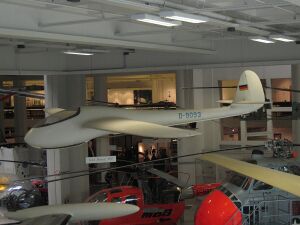Engineering:Akaflieg Stuttgart FS-24
| FS 24 Phoenix | |
|---|---|

| |
| FS-24 in the Deutsches Museum in Munich | |
| Role | Sailplane |
| National origin | Germany |
| Manufacturer | Akaflieg Stuttgart |
| Designer | R. Eppler and H. Nägele |
| First flight | 27 November 1957 |
| Number built | 8 |
The Akaflieg Stuttgart FS-24 Phoenix was a glider designed and built in Germany from 1951.
Design and development
The Phoenix was the first glider to use fibreglass in its construction. The development of modern aerofoil sections for gliders required very accurate reproduction with smooth surfaces, using tolerances that were extremely difficult to achieve using conventional wood or metal construction, but could be achieved by using composite materials laid up in a mould.
The design of the FS-24 was started at Akaflieg Stuttgart, (Akademische Fliegergruppe - academic flying group), by R. Eppler and H. Nägele in 1951. Originally it was constructed of balsa wood with a strengthened outer layer of paper and glue layers, which was not satisfactory. The project was abandoned until a grant was received for further research from Baden-Württemberg state. By then glass fibre reinforced polyester resin was available and so it was redesigned using a balsa wood/glass fibre 'sandwich', with the load-bearing points and the edge of the cockpit canopy strengthened with plywood.
At the time the Phoenix was designed, emphasis was placed on climb performance rather than high cruising speed, with a low wing loading to optimise thermalling and a faster cruise speed (best Lift /Drag speed) achieved through careful attention to fuselage shape, wing incidence, aspect ratio and other criteria.
The first flight was made on 27 November 1957, and good performance and excellent handling were demonstrated, especially in weak thermal conditions. For its first flights the prototype had a conventional tail unit and fixed undercarriage, but later a T-tail and retractable undercarriage were fitted. Flaps on the underside of the wing trailing edges could be used to control the glideslope on landing, with minimal trim change. Eight examples of the Phoenix were built and all were still flying in 1980, with at least one example now preserved in the Deutsches Museum in Munich and another in the Deutsches Segelflugmuseum at Wasserkuppe.
Variants
- FS 24 Phoenix
- 16m sailplane certified in January 1959 and manufactured by Akademische Fliegergruppe Stuttgart
- FS 24 Phoenix TO
- 16m sailplane with a T-tail certified in May 1960 and manufactured by Apparatebau Nabern.
- FS 24 Phoenix T
- 16m sailplane certified in April 1961 and manufactured by Apparatebau Nabern.
Surviving aircraft
The prototype fs 24 Phönix is on display at the Deutsches Museum in Munich, Germany .[1]
D-8353 is part of the collection of the Deutsches Segelflugmuseum at Wasserkuppe, Germany.[2]
Specifications
Data from The World's Sailplanes:Die Segelflugzeuge der Welt:Les Planeurs du Monde[3][4]
General characteristics
- Crew: 1
- Length: 6.84 m (22 ft 5 in)
- Wingspan: 16 m (52 ft 6 in)
- Height: 0.95 m (3 ft 1 in)
- Wing area: 14.36 m2 (154.6 sq ft)
- Aspect ratio: 17.83
- Airfoil: EC 86 (-3) - 914
- Empty weight: 161.7 kg (356 lb)
- Max takeoff weight: 265 kg (584 lb)
Performance
- Stall speed: 43 km/h (27 mph, 23 kn)
- Never exceed speed: 140 km/h (87 mph, 76 kn)
- Rough air speed max: 100 km/h (62.1 mph; 54.0 kn)
- Aerotow speed: 100 km/h (62.1 mph; 54.0 kn)
- Winch launch speed: 90 km/h (55.9 mph; 48.6 kn)
- g limits: +4 -2
- Maximum glide ratio: ~37 at 77–80.2 km/h (47.8–49.8 mph; 41.6–43.3 kn)
- Rate of sink: 0.53 m/s (104 ft/min) at 69.2 km/h (43.0 mph; 37.4 kn)
- Wing loading: 18.5 kg/m2 (3.8 lb/sq ft)
See also
Aircraft of comparable role, configuration and era
- Hirth Hi25 Kria
Related lists
References
Notes
- ↑ "Akaflieg Stuttgart fs-24 Phönix, 1957". http://www.deutsches-museum.de/en/collections/transport/aeronautics/sailplanes/phoenix/. Retrieved 13 June 2013.
- ↑ "Bölkow fs-24 "Phönix T0"". http://www.segelflugmuseum.de/boelkow_fs_24___phoenix_t0___4213.html?psid=386fde1a0ce8776a6a6ea3ccfce0c268. Retrieved 13 June 2013.
- ↑ Shenstone, B.S.; K.G. Wilkinson; Peter Brooks (1958) (in French, German). The World's Sailplanes:Die Segelflugzeuge der Welt:Les Planeurs dans Le Monde (1st ed.). Zurich: Organisation Scientifique et Technique Internationale du Vol a Voile (OSTIV) and Schweizer Aero-Revue. pp. 51–54.
- ↑ "fs 24 - Phönix". Stuttgart University. http://www.uni-stuttgart.de/akaflieg/index.php?id=44&L=2. Retrieved 13 June 2013.
Bibliography
- "fs 24 - Phönix". Stuttgart University. http://www.uni-stuttgart.de/akaflieg/projekte/die-flugzeuge/fs24-phoenix/. Retrieved 8 September 2015.
- "Bölkow fs-24 "Phönix T0"". http://www.segelflugmuseum.de/boelkow_fs_24___phoenix_t0___4213.html?psid=386fde1a0ce8776a6a6ea3ccfce0c268. Retrieved 13 June 2013.
- "Akaflieg Stuttgart fs-24 Phönix, 1957". http://www.deutsches-museum.de/en/collections/transport/aeronautics/sailplanes/phoenix/. Retrieved 13 June 2013.
- Shenstone, B.S.; K.G. Wilkinson; Peter Brooks (1958) (in French, German). The World's Sailplanes:Die Segelflugzeuge der Welt:Les Planeurs dans Le Monde (1st ed.). Zurich: Organisation Scientifique et Technique Internationale du Vol a Voile (OSTIV) and Schweizer Aero-Revue. pp. 51–54.
External links


